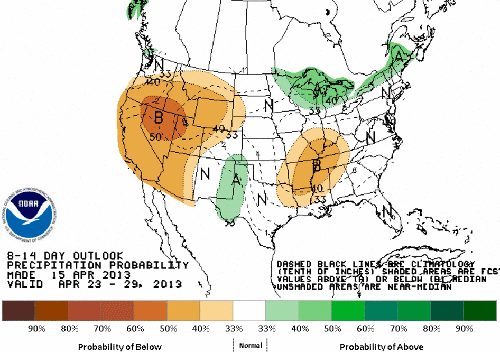Southwest Michigan may shift to drier weather, but cool conditions expected to remain
The 6-10 and 8-14 day outlooks call for more normal precipitation patterns over Michigan’s southern counties; temperatures expected to remain below normal; much of the Western United States remains drier than normal.
We may be seeing a return to more normal precipitation patterns in the 8-14 day outlook from NOAA across the southern tier of Michigan counties. However, cooler than normal conditions are expected to remain in place over much of the eastern portion of the country during this period.

The recent rainfall has helped to provide recharge water for southwest Michigan’s surface and ground water resources. Water levels in lakes, ponds and streams across the region had begun to recede following “ice-out” in late March. Rainfall totals ranging from 2 to 3 inches over the last week across the region have helped to bring water levels back up significantly. With anticipated heavy rainfall expected on April 18, we should be able to add to these reserves. This also should help to eliminate any dry subsoil conditions that may have existed following extreme drought, which was prevalent in many places across southern Michigan last summer.
In general, southwest Michigan growers are still sitting in pretty good shape this year. A good deal of primary tillage was conducted under nearly ideal conditions last fall. And growers were able to take advantage of dry conditions during brief periods earlier this spring on lighter textured soils to work up some additional acreage.
Growers should exercise caution in getting into fields that are too wet to work and plant. It is very easy to destroy the positive effect of fall tillage by trafficking the field under wet conditions. Compaction can cause soil clods, which can lead to poor seed-to-soil contact. Planting into wet conditions can cause sidewall compaction issues that can reduce seedling root growth. Both of these challenges can reduce stand uniformity, growth and yield potential.
Keep an eye on soil temperatures before planting. Temperatures below 50 degrees F can cause problems for both corn and soybeans. If you plant early, be especially concerned about soil temperatures at the time of planting and the subsequent 24 to 36 hours. Also refer to your field notes to see if you have experienced challenges with seedling diseases in the past. Cool and wet conditions can lead to seedling disease issues, especially in soybeans. Fungicide seed treatments will have the greatest potential for providing a return on investment in fields with history of phytophthora and pythium. Metalaxyl/Mefenoxam based fungicides work well with these diseases. In fields with SDS History, cool/cold and wet conditions can increase infection rates. You may want to plant these fields later in the season when the soils have warmed up and the plants will emerge more quickly.
As thunderstorms are expected to fire up and the temperatures are expected to follow a rollercoaster pattern with the passage of warm and cold fronts, there is potential for a deposition of black cutworm and armyworm moths closer, if not into, Michigan. Michigan State University Extension is beginning monitoring for these early season pests with pheromone traps in a few locations across the state.
The Western United States remains dry. Expanding areas of western drought can cause impacts for our weather later in the season. Be careful when wishing for drier conditions to return as we may get what we ask for.



 Print
Print Email
Email

